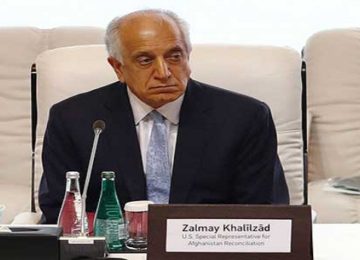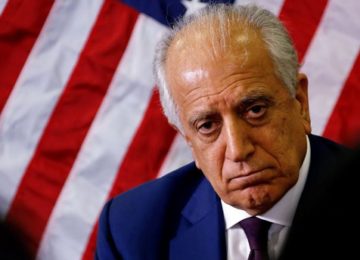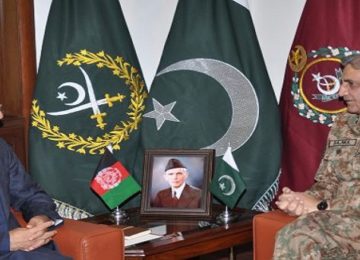The Monitoring and Evaluation Committee (MEC), an independent anti-corruption body in Afghanistan, recently released its ‘vulnerability to corruption’ assessment of the Ministry of Education. The assessment points to 36 different types of corruption within the education sector, highlighting that corruption has become endemic in the last 10 to 15 years and that malpractice is systemic within the ministry. AAN’s Jelena Bjelica summarises the report’s findings and recommendations and concludes that this is the first eye-opening report on corruption produced by an Afghan institution.
Education in Afghanistan has frequently been touted as one of the more successful development assistance interventions in the country in the last 15 years. This narrative may have reached a cathartic turn, now. A 170-page vulnerability to corruption assessment of the Afghan Ministry of Education (MoE) (full report available here), released on Thursday 26 October in Kabul by the Independent Joint Anti-Corruption Monitoring and Evaluation Committee (MEC)(1), identified systematic practices of corruption within the ministry that “ranged from school-level issues, such as bribes to modify school certificates, through to ministry-level issues such as corruption in school construction and in textbook distribution.” Put simply, this rather grim read indicates that the entire education sector is either corrupt or vulnerable to corruption. In particular, the report highlights the issue of the “country-wide appointment of teachers on the basis of influence, or nepotism and bribery,” which, according to the MEC, emerged as the most serious issue.
The study was undertaken at the request of then acting-education minister Asadullah Hanif Balkhi in July 2016 (Balkhi lost a vote of confidence in parliament in November 2016, although continued in his post at the request of the president, see AAN’s analysis here.) This is the second time that Balkhi has shaken the ministry to its core. The first time was when, in December 2016, he publicly disputed the number of school-age pupils in Afghanistan given by his predecessor (at over 11 million), stating that the real number was significantly lower.
The MEC assessment is also the first comprehensive evaluation of corruption within the Ministry of Education. It was carried out in Kabul and nine other provinces (Badakhshan, Balkh, Faryab, Ghazni, Herat, Khost, Bamyan, Panjshir and Nangrahar) and included an assessment of 138 schools. (2) The assessment highlights 36 different types of corruption within the ministry and provides over sixty recommendations. The MEC, in its press release, made a blasting statement: “Taken together, [the 36 types of corruption] constitute a corruption of the very ideal of education in Afghanistan,”
The MEC’s main findings
- The Education sector as a corrupt job market
According to the MEC report, the education ministry is the single largest employer in the civil sector. In 2015, the civil service (which was supposed to be reformed, see this 2016 AREU study: was estimated to employ over 400,000 people. The MoE, with its 262,000 staff (of whom 216,000 are teachers, according to the MoE’s Human Resources Department), constituted 68 per cent of its total and is a job market susceptible to corruption.
MEC interviews conducted across the sector confirmed that “Corruption related to the appointment of teachers was the principal issue reported by over 90 per cent of the interviewees.” It further notes (page 24):
This result was replicated across all six tiers of interviewees [see endnote 2], all schools and all provinces. The comments all referred to nepotism, favoritism and preference by MoE staff and preference by influential persons, including Members of Parliament (MPs) […] The MEC interviews found that the pressure for MoE to subvert its procedures to employ relatives, friends and favored individuals is relentless and ubiquitous, reported by literally hundreds of interviewees. The most frequent pressure comes from MPs. Interviewees reported MPs intervening at all levels of hiring and promotion, and in the placing of teachers in desirable locations. (pages 24 and 25)
Additionally, the MEC found that payments-for-appointment were widespread throughout the sector:
A widespread practice of payment-for-appointment has now become entrenched, requiring an average of between [Afghani] 50,000 to 70,000 (about USD 800 to 1,000) from the applicant. The amount varies depending on the attractiveness of the position. This has also meant that some teachers have been forced to seek additional work outside of school to feed themselves and their families because they have had to pay the equivalent of one or two year’s salary to secure a teaching position. (pages 25-6)
In Afghanistan, stable, full-time employment is hard to come by. According to official Afghan government statistics, of the 7.2 million Afghans who have a job, only 19 per cent have job security, leaving 81 per cent to worry about the permanence of their positions. Statistics indicate that over 26 per cent of young people qualified to work are unemployed. According to the MEC’s findings, the high number of teacher unemployment (some 75 per cent of Teacher Training College graduates are unable to find work) is likely due, in large part, to this corruption. There are widespread related problems, such as a corrupt system of examinations, payment being required to obtain a teaching position, corrupt recruitment procedures, teachers paying to stay on beyond retirement age, gender bias and teachers demanding bribes. (Verbal and physical abuse of children is also listed as another major problem.) In conclusion, the MEC noted that corruption in teachers’ appointments is the single most dangerous practice threatening students’ education, as parents and communities at large have lost confidence in the system (before the war, teaching was a highly respected profession).
The MEC also found that corrupt recruitment practices often, if not always, entail nepotism and favouritism, or, as the report stated: “applicants who are not from among a particular affiliation – family, tribal, political – will generally be unsuccessful in gaining an actual appointment.” In addition, a lack of reliable records coupled with non-transparent recruitment processes and an absence of performance management, renders the system particularly vulnerable to corrupt practices.
- Textbooks as subversion of development assistance
The ministry has been wholly reliant on donor support to print and deliver textbooks to schools across Afghanistan since 2002. For example, USAID has provided support for printing and distributing over 130 million primary and secondary grade textbooks in Afghanistan since then. Between 2003 and 2015, Denmark contributed to the financing of a total of 144.8 million textbooks benefitting a minimum of eight million students (see this 2017 DANIDA – Denmark’s Development Cooperation evaluation report of the education sector). DANIDA also financed storage for textbooks: in total, 38 warehouses and 17 containers were financed to prevent textbook damage (each warehouse accommodating between 800,000 to 1,2 million textbooks). Until 2010, however, the main issue was with the procurement of printing services:
For example, a single Afghan publishing company won five out of six textbook procurement tenders between 2004 and 2010, despite not meeting the contractual obligations to print the books in-country. The DPs [development partners] most involved in textbook procurement – USAID and DANIDA – have implemented measures to improve procurement procedures and minimize corrupt practices at the highest level, though further problems have emerged down the supply line. (page 63)
These “further problems” included books initially delivered to Kabul not being distributed to provincial and district warehouses or on to schools. And, yet, since the books are financed by the development assistance funds, they are meant to be distributed free of charge. MEC researchers observed that:
A stark reality which consistently confronted the MVCA researchers in the field, has been the absence of textbooks in classrooms. It was common to observe very few textbooks at all, and those present were often of poor quality, old and shabby, or poorly produced photocopies of long-lost originals. Therefore many of these textbooks are not aligned to reflect the curriculum modifications and frequently for many subjects, a single book was observed being shared among three students. […] Usually the books that students receive from school are old black and white versions whereas new books, of good quality, and full-color, are available in the local bazaar. In some schools, or in places where students have a close relationship with teachers or the school principal, they get a complete set of books – while other students in the same classes and schools have to buy their books. In the cities, all the books are usually available in the market, but in the villages and rural areas, some books are not available, so the students ask the school administration to provide the books for them, reportedly to no avail. (pages 62 and 63)
As parts of the curriculum have undergone several revisions, each revision has required new textbooks to be printed. This has enabled further, extensive corruption, especially in the distribution of textbooks since 2010, as new prints have been required more often. Students all across the country, MEC found, have to buy their own textbooks, which are meant to be free.
- Unmanageable ministry
The Ministry of Education is so large and so bogged down in corruption that it is almost unmanageable in the Afghan context, the MEC concluded.
Being a highly centralized system, the source of most of the problems – and the solutions – is to be found at the heart of the system, with the Ministry and the officials in Kabul. The problems of extensive nepotism, weak controls, inefficient and corruption-prone procedures and policies are all well-known and are long-standing, dating back at least 15 years. (page 73)
The MEC further reported that the MoE’s Payroll Department was unable to provide an accurate figure of the number of people it had paid in the last three months. (page 24) Furthermore, salaries continue to be paid in cash in most provinces, which increases the risk of corruption. (There has been a similar problem with the police and armed forces, although it is being tackled – see AAN’s previous analysis on the reform of the Ministry of Interior).
Procurement procedures also continue to be susceptible to corruption. This causes delays for most projects, with some left incomplete for years. The MEC noted that improved external verification of school construction, including by donors, was required.
There are no checks or balances in the MoE, the anti-corruption committee found. One recommendation highlighted the need for “routine, independent inspection of the quality of education in the schools. At present school quality inspection is ineffective and not independent.”
- A lack of reliable records
As AAN reported earlier in 2017, there are no reliable records and many inconsistencies in Afghan education statistics (with the number of students nationwide counted as anything between six to ten million). This discrepancy in itself may indicate widespread corruption throughout the sector, as it allows for the manipulation of development assistance and practices based on inaccurate numbers and baselines. The data collected by the MEC for the 138 schools it visited showed that official numbers were 23 per cent higher than the number of students actually attending. (The MEC only obtained official data for 88 schools of the 138 it visited). The committee carefully concluded that:
This data sample is too small for any generalizable conclusions. However, given that MEC did not analyses the most insecure provinces, where the attendance is likely to be still lower than enrolment, this finding therefore needs urgent attention by those reviewing EMIS [Education Management Information System] data quality.
The MEC further indicated that the quality of the data gathered by EMIS at both the district and provincial levels was questionable and that a lack of reliable data impedes planning. The anti-corruption committee warned that “owing to unreliable data processing, the central database cannot be populated accurately,” and that “the absence of accurate data has facilitated the generation of ‘ghost schools,’ ‘ghost pupils’ and ‘ghost teachers’” – as reported by AAN in this 2013 analysis.
- Corrupt adult literacy programmes
The anti-corruption committee further found that adult literacy programmes were substantially corrupted:
Feedback from interviewees was widespread that these programs were often non-existent in the Provinces. Officers in the Deputy Ministry for Literacy themselves acknowledged many challenges and vulnerabilities in the implementation of the programs and poor coordination between MoE and MoLSAMD [Ministry of Labour, Social Affairs, Martyrs and Disabled]. Weak oversight led to problems in multiple locations, including improper implementation, collusion to hide the absence of any implementation, inappropriate and fraudulent participants, and numerous ‘ghost’ program sites. (page 60)
Additionally, the Technical Vocational Education & Training (TVET) run by the MoE had an outdated curriculum that was unrelated to the employment market. The MEC’s researchers found that some teachers in this field were also corrupt and that many teachers in the MoE-run programmes were incompetent. The report noted that TVET programmes run by non-governmental organisations, both local and international, were of a much higher quality than the MoE programmes.
- Other issues
The MEC’s detailed report highlights a number of other issues that hamper the reliability of the education sector. To list a few, the professional capacity of officers at the MoE to conduct performance management is generally regarded as low; the proportion of committed teachers is reported to be declining; and the frequent alterations to the curriculum enable further corruption. According to the MEC, this means that the curriculum “is beyond the competence of many teachers,” and because of this, “they have to resort to dishonest methods to help the students get through the exams.”
This inevitably leads to a low level of education and a general loss of trust among communities in their education providers.
MEC recommendations
The MEC’s recommendations (of which there are 66) are structured in ten categories, which, among other things, call for local responsibility, institutional reforms, legal reforms, increased transparency and better enforcement. At the local level, the MEC calls on school communities to bear the primary responsibility for selecting their teachers, instead of the corrupt MoE’s provincial departments. Institutional reform, according to the MEC, should entail a reduction of the size and scope of the MoE, in order to make it more manageable and less vulnerable to corruption. This would include reforming the mechanism for selecting teachers and a revision of the size of the curriculum. A successful change of the MoE, according to MEC’s recommendation would be a two-fold approach, which requires, at the local level, community-led appointments of teachers and, at the central-level, to establish a full-time task force with strong cabinet backing as well as a clear metric by which to measure success in cleaning up teachers’ appointments. The anti-corruption committee also suggests that the Technical Vocational Education & Training be an autonomous entity outside of the MoE.
In terms of legal changes, the MEC recommended that the “MoE leadership make and implement a new policy of actively challenging and reacting to corruption.” A positive step for immediate change would include the establishment of an independent complaints body tasked with investigating corruption within the MoE, as well as increased visibility and local accountability regarding teachers’ appointments. Regarding the international community, the MEC recommended that donors quickly signal their support for a new focus on anti-corruption and on independent oversight as the basis for raising the quality of education. The MEC also recommended improvements to Education Management Information System (EMIS) and the human resources systems, independent oversight, increased transparency, greater enforcement (which would mean that the Attorney General’s Office actively take up the backlog of MoE corruption cases), and market-based alternatives, such as vouchers, for the purchase of textbooks by students and parents).
Sound recommendations, but to what end?
The MEC’s report stands out as the clearest and most blunt assessment of corruption in Afghanistan’s education sector so far. Previous reports, among them most prominently the reports of the United States Special Inspector General for Afghanistan Reconstruction, have detailed some corrupt practices within the ministry, but none has captured the extent and magnitude of corruption in education as the MEC report has done.
Some of the report’s excellent recommendations rightly call for immediate action. But the report leaves the reader wondering how much can be repaired and how quickly, given the scale and depth of the corruption within the ministry. World Bank corruption experts, for example, have shown (page 11) that such institutional transformation takes decades. Given the role of political patronage in teachers’ appointments and other elements of politicisation in the educational system (see this AREU report: and AAN here), a solution to these problems requires not only political will, but enormous courage. Whether the Afghan government can muster such political courage to prioritise these issues remains uncertain.
The report has one advantage, however: unlike an earlier report by a president-appointed fact-finding mission, the results of which were not allowed to be published (see here), the MEC’s report is publicly available and everyone – students, parents, teachers, parliament members and donors – has the chance to read what is wrong in the Afghan education system, as well as how it could, potentially, be put right.
(1) The MEC is an independent agency created in 2010 set up following the London Conference commitments. It was established based on Presidential Decree 61/2010, which primarily regulated the establishment of the High Office of Oversight and Anti-corruption, and, in Article 8, the establishment of a Monitoring and Evaluation Committee, “within the framework of this Office, consisting of the national and international experts on the field of fighting corruption.” The Committee, Article 8 stated, is “required to assist governmental organs in determining effective development benchmarks and, with the necessary monitoring and evaluations, provide six-month report to the president, national assembly, international community and the public regarding activities on fighting against corruption at the national level as well as on assistance of the international community and donors.”
On 18 September 2016, the Afghan president issued Presidential Decree No. 115/2016, which changed the legal status, duties, scope of activities and authorities of the Independent Joint Anti-Corruption Monitoring and Evaluation Committee. A new presidential decree gave the MEC a truly independent status, with its own “limited tashkil (organizational structure and staffing).” It also stipulated in Article 3 that “all the government organizations and international institutions, while offering their full cooperation, are obliged to provide the Independent Joint Anti-Corruption Monitoring and Evaluation Committee with the statistics and information needed for the evaluation, and implement the recommendations of the Committee and regularly report the state of implementation of these recommendations to the Independent Joint Anti-Corruption Monitoring and Evaluation Committee.”
The MEC’s central structure – a committee – still includes both national and international experts, notably three national and three international commissioners. While national experts are directly appointed by the president, all international appointments are subject to presidential approval.
(2) The MEC carried out 542 interviews with five groups of people: ministry officials (109), provincial education officials (126); training colleges (76), teachers (93), parents and students (125), development partners and others (22). It also conducted 160 focus group discussions.
By Special Arrangement with AAN. Original link.
Disclaimer: Views expressed on this blog are not necessarily endorsed or supported by the Center for Research and Security Studies, Islamabad.








